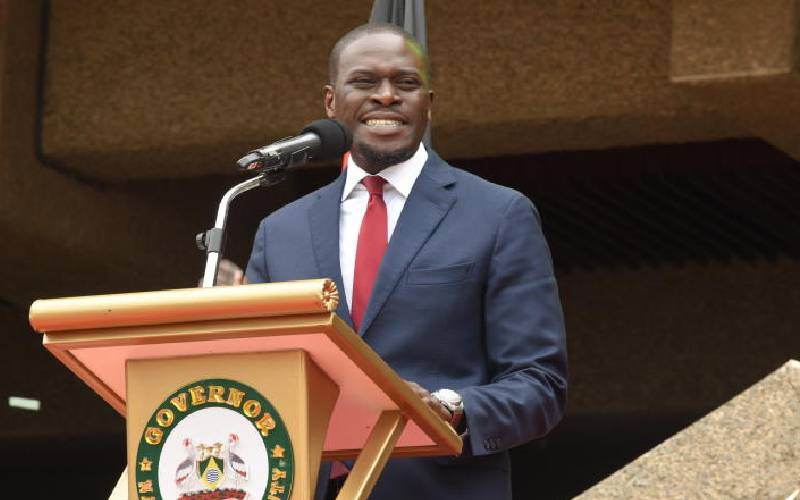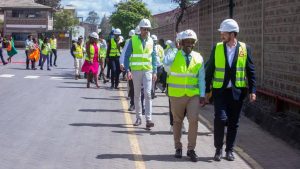Governor Sakaja’s nod for photographers, content creators prove a revolutionary game changer


By Kenn Okaka
Take everything away from Nairobi City County Governor Johnson Sakaja, but the revolutionary action by his administration to waive permit requirement for photographers, videographers and content creators was a real game changer in opening new frontiers and creating thousands of jobs for young talented Kenyans in Nairobi.
This is one of the most notable actions that Sakaja has taken during his administration and it took off proving to be an instant job creation avenue for the people of Nairobi.
Back in 2022, Sakaja issued a directive waiving permit requirements for freelance photographers and videographers within the Nairobi Central Business District opening the space for digital content creators and creating thousands of jobs for unemployed youths in Nairobi.
It was a win for creatives as Sakaja’s directive eased operations for Nairobi residents, mostly the youth in the film and creative industry who now breathe a sigh of relief as the laws that there before prohibited photography, videography, filming on the streets without a license from city hall.
In a memo dated September 23rd 2022, the Nairobi County Government under the leadership of Governor Johnson Sakaja allowed photographers and content creators the permission to film on the streets of Nairobi. The Sakaja led administration waived permit requirements for freelance photographers and videographers easing the pain for artists, photographers and content creators who had long complained over harassment by county officials and the requirement to pay hefty permit fees of over Ksh5,000 to shoot in the city.

“In exercise of the power given under the PFM Act 2012, Section 159 and the Nairobi City Council Tax Waivers Administration Act, 2013 Section 5 (2)(C), approval is hereby given that Freelance photographers and Freelance filmmakers are given waiver/exemption from payment of Single Business Permit as charged under the Nairobi City County Trade Licensing Act, 2019,” the memo read in part.
The decision was testament of the commitment Sakaja had promised to boost the creative industry in the city by ending the harassment of photographers and videographers as well as the expensive permit fees.
“When we say we want to be pro-business it is not just passive to stop harassment of traders but we want to be proactive to facilitate and promote. There are many archaic laws including those that hamper creativity and innovation and we are going to weed those out. Businesspeople should spend more time doing business and not chasing compliance issues,” Sakaja said.
Creatives, especially photographers and videographers, have for long been engaged in a tussle with county officials over requirements to be allowed to shoot in the capital.
Usually, they have had to obtain a permit from the Department of Filming Services, through a filming agent, a letter from the police, and fork out amounts of up to around Ksh. 5,000 for a single day but now the digital content creators have a field day recording their content. This is in stark contrast with the norm in the past.
According to a survey conducted by our team in the Nairobi Central Business District (CBD), thousands of people every day have the opportunity to film and take photographs in the CBD, content which is then used to create digital content for social media monetization, even as the freelance photographers enjoy their time at work serving their customers on the streets without the fear of harassment from county government enforcement officers.
For instance, I took a short walk along Kenyatta Avenue; It is Sunday afternoon and I noticed more that 15 sets of digital photography setups along the route. On the other side of the road, between City Hall Annex and Six Eighty Hotel, a stretch of a mere 100 meters, there were 10 groups of photographers, each group comprising of at least three people, all of them youthful men and women in their early twenties, the GenZs, and all of them are armed with state-of-the-art digital cameras and accessories. They have set up reflective umbrellas and customers are all changing poses for the cameras. The same is replicated in the CBD from Tom Mboya street moving into the upper parts of town where there are an estimated 1000 locations employing over 20,000 youths have been employed into this trade.
The youth in this business say that weekends are a boom and one can easily make between Ksh 10,000 to Ksh 15,000. These are just the physical photographers on the street. The customers, most of them the youth are into online content creation. Although it may have started as just photography for fun, street photography has grown rapidly and quickly became a form of self-employment for many youths with a passion for the arts. Social media is a driving force for this kind of photography. It acts as the photographer’s portfolio, showcasing their best shoots and attracting new clients. Not only that, but young Kenyan men and women will go to great lengths to get flawless pictures for their Instagram feeds while the short videos will their way to social media sites like where these young men and women package their content for the thousands of their online followers.
So, with just a single directive, Sakaja opened up a whole creative industry, giving a chance to thousands of youths to eke a living from the trade.
These young men and women are of the same age with the Gen Z youths who have been leading anti-government protests clearly indicating that given an opportunity, the youth are ready and capable of transforming their lives positively.
The street photographers are on the streets everyday but weekends are the peak days for business and thousands of people stream into the CBD o have a photo moment on the streets of NAIROBI, for the photographers, they have no rent obligations and therefore, Sakaja’s nod to their trade meant ease of doing business, and to the county, the youths, armed with a camera and reflective umbrella, they ensure that their locations are clean for their clients and it is those clean streets that they leave in the evening.
Compared to yesteryears, residents would come to Nairobi just to have phot at Uhuru Park of the KICC, yet those conventional photos would only be available to them the following week but now, there has been a real revolution, which is a real game changer in the trade.
Indeed, Sakaja’s move to allow street photography in Nairobi is one that has proven that creation of employment can be achieved silently, without having to set up commissions or holding tens of seminars and should be emulated across other major cities and towns in Kenya as Sakaja has demonstrated that it only requires a leader who is willing to listen to the electorate and allow them the space to develop their crafts into thriving businesses.





